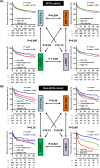Validation of non-muscle-invasive bladder cancer risk stratification updated in the 2021 European Association of Urology guidelines
- PMID: 38371197
- PMCID: PMC10869660
- DOI: 10.1002/bco2.305
Validation of non-muscle-invasive bladder cancer risk stratification updated in the 2021 European Association of Urology guidelines
Abstract
Objective: The objective of this study is to validate the predictive ability of the 2021 European Association of Urology (EAU) risk model compared to that of existing risk models, including the 2019 EAU model and risk scoring tables of the European Organization for Research and Treatment of Cancer, Club Urologico Espanol de Tratamiento Oncologico, and Japanese Nishinihon Uro-oncology Extensive Collaboration Group.
Patients and methods: This retrospective multi-institutional database study included two cohorts-3024 patients receiving intravesical bacillus Calmette-Guerin (BCG) treatment (BCG cohort) and 789 patients not receiving BCG treatment (non-BCG cohort). The Kaplan-Meier estimate and log-rank test were used to visualize and compare oncological survival outcomes after transurethral surgery among the risk groups. Harrell's concordance index (C-index) was used to evaluate the predictive ability of the models.
Results: We observed a risk shift from the 2019 EAU risk grouping to the 2021 EAU risk grouping in a substantial number of patients. For progression, the C-index of the 2021 EAU model was significantly higher than that of the 2019 EAU model in both the BCG (0.617 vs. 0.572; P = 0.011) and non-BCG (0.718 vs. 0.560; P < 0.001) cohorts. According to the 2021 EAU model, 731 (24%) and 130 (16%) patients in the BCG and non-BCG cohorts, respectively, were considered to have a very high risk. Survival analysis showed no significant differences among the five very high-risk subgroups in both cohorts. A major limitation was potential selection bias owing to the retrospective nature of this study.
Conclusions: The updated 2021 EAU model showed better stratification than the three existing risk models, especially for progression, in both cohorts, determining the most appropriate postoperative treatment and identifying patients requiring intensified surveillance or early cystectomy.
Keywords: prediction; prognosis; progression; recurrence; risk; urinary bladder neoplasms.
© 2023 The Authors. BJUI Compass published by John Wiley & Sons Ltd on behalf of BJU International Company.
Conflict of interest statement
The authors disclose no potential conflict of interest.
Figures





References
-
- Miyake M, Iida K, Nishimura N, Miyamoto T, Fujimoto K, Tomida R, et al. Non‐maintenance intravesical bacillus Calmette‐Guérin induction therapy with eight doses in patients with high‐ or highest‐risk non‐muscle invasive bladder cancer: a retrospective non‐randomized comparative study. BMC Cancer. 2021;21(1):266. 10.1186/s12885-021-07966-7 - DOI - PMC - PubMed
-
- Miyamoto T, Miyake M, Nakahama T, Nishimura N, Onishi K, Iida K, et al. Validation of the risk stratification newly defined in the Japanese Urological Association guidelines 2019 for non‐muscle invasive bladder cancer: a multi‐institutional collaborative study. Int J Urol. 2023;30(5):473–481. 10.1111/iju.15162 - DOI - PubMed
-
- van Rhijn BWG, Hentschel AE, Bründl J, Compérat EM, Hernández V, Čapoun O, et al. Prognostic value of the WHO1973 and WHO2004/2016 classification systems for grade in primary Ta/T1 non‐muscle‐invasive bladder cancer: a multicenter European association of urology non‐muscle‐invasive bladder cancer guidelines panel study. Eur Urol Oncol. 2021;4(2):182–191. 10.1016/j.euo.2020.12.002 - DOI - PubMed
LinkOut - more resources
Full Text Sources
